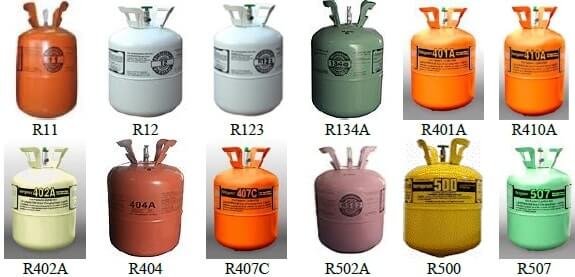Refrigerants are substances that are used in the cooling cycle of air conditioning systems and heat pumps, consisting of chemical components, and in most cases provide heat transfer by passing from liquid to gas and then from gas to liquid.
Refrigerants can be pure or a mixture of pure liquids in liquid or gaseous phase or both, depending on temperature and pressure. The fluid absorbs heat at low temperature and low pressure and then gives off heat at higher temperature and pressure, usually through a change of state.
First Refrigerant
The first refrigerant was created by Thomas Midgley Jr. in 1928. introduced Freon (R-12), the first chlorofluorocarbon gas that is non-flammable and non-toxic. This refrigerant was used in refrigerators and air conditioners for many years.
Then, in the early 1980s, scientists discovered that CFCs were causing great damage to the ozone layer that protects the earth and to ozone holes in the polar regions.
Refrigerants

Nowadays, many refrigerants have been discovered and some have been banned because they are harmful. Refrigerants can be examined in three categories: chlorofluorocarbon (CFC), hydrochlorofluorocarbon (HCFC) and hydrofluorocarbon (HFC).
Chlorofluorocarbon (CFC):
R11 ( Freon 11 )
R12 ( Freon 12 )
R13 ( Freon 13 )
R14 ( Freon 14 )
R113 ( Freon 113 )
R114 ( Freon 114 )
R500 ( Freon 500 )
R502 ( Freon 502 )
Hydrochlorofluorocarbon (HCFC):
R21 ( Freon 21 )
R22 ( Freon 22 )
R123 ( Freon 123 )
R124 ( Freon 124 )
R401 ( Freon 401 )
R402 ( Freon 402 )
R403 ( Freon 403 )
R405 ( Freon 405 )
R406 ( Freon 406 )
R408 ( Freon 408 )
R409 ( Freon 409 )
Hydrofluorocarbon (HFC):
R23 ( Freon 23 )
R125 ( Freon 125 )
R134a ( Freon 134a )
R404A ( Freon 404A )
R407 ( Freon 407 )
R410 ( Freon 410 )
R413 ( Freon 413 )
R417 ( Freon 417 )
R507 ( Freon 507 )
Other Refrigerants
R50 (Methane)
R717 (Ammonia)
R718 (Water)
R728 (Nitrogen)
R719 (Air)
R732 (Oxygen)
R740 (Argon)
R744 (CO2 – Carbon Dioxide)
Banned Or Phased out Refrigerants
The use of some refrigerants is prohibited due to the damage they cause to the environment and the ozone layer.
R-11 (CFC-11): Production was banned in developed countries by Montreal Protocol in 1996
R-12 (CFC-12): Also known as Freon, a widely used chlorofluorocarbon halomethane (CFC). Production was banned in developed countries by Montreal Protocol in 1996, and in developing countries (article 5 countries) in 2010.
R-22 (HCFC-22): A widely used hydrochlorofluorocarbon (HCFC) and powerful greenhouse gas with a GWP equal to 1810. Worldwide production of R-22 in 2008 was about 800 Gg per year, up from about 450 Gg per year in 1998. R-438A (MO-99) is a R-22 replacement.
R-123 (HCFC-123):Used in large tonnage centrifugal chiller applications. All U.S. production and import of virgin HCFCs will be phased out by 2030, with limited exceptions.[65] R-123 refrigerant was used to retrofit some chiller that used R-11 refrigerant Trichlorofluoromethane. The production of R-11 was banned in developed countries by Montreal Protocol in 1996.
Classification of refrigerants
Refrigerants may be divided into three classes according to their manner of absorption or extraction of heat from the substances to be refrigerated:
- Class 1: This class includes refrigerants that cool by phase change (typically boiling), using the refrigerant’s latent heat.
- Class 2: These refrigerants cool by temperature change or ‘sensible heat’, the quantity of heat being the specific heat capacity x the temperature change. They are air, calcium chloride brine, sodium chloride brine, alcohol, and similar nonfreezing solutions. The purpose of Class 2 refrigerants is to receive a reduction of temperature from Class 1 refrigerants and convey this lower temperature to the area to be cooled.
- Class 3: This group consists of solutions that contain absorbed vapors of liquefiable agents or refrigerating media. These solutions function by nature of their ability to carry liquefiable vapors, which produce a cooling effect by the absorption of their heat of solution. They can also be classified into many categories.



